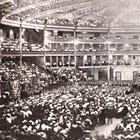Today's Tidbit... White and Yellow Footballs for Night Games
A reader asked recently whether I had written about the yellow footballs in the past, and unfortunately, I lost track of who asked the question. My memory loss does not change the fact that I have not written about yellow footballs specifically, but I scratched the surface on white, yellow, and striped footballs back in the days and nights when stadium lights were none too bright.
The earliest reference I find to using footballs that are not tan comes in 1904 when Stagg, who was also among the first coaches whose teams regularly practiced under the lights, had his teams use white footballs when practicing at dusk and in the evening. That was in the pre-forward pass days, but teams punted a lot, and players needed to see the ball under poor illumination, so they painted the balls white.
White footballs became a more prominent topic in the 1920s as a few teams began playing night games semi-regularly. During that period, they used the PYOB (Paint Your Own Ball) approach since the equipment catalogs did not mention white balls until 1932 or so, when the manufacturers started offering white or yellow versions of their higher-price balls. The catalogs do not show examples of lighter-skinned balls. They only note their availability, and they do not mention stripes.
The first Big Ten night game, the 1935 Purdue at Northwestern game, used a white ball with black stripes, so at least one manufacturer added stripes to enhance the ball's visibility by then.

The earliest catalog I have showing a non-tan football is the 1940 GoldSmith version, which offers two versions of the white ball. One has thin black stripes painted along the ball's seams. The thin stripes do not seem helpful for seeing the ball, but if anyone has one lying around, toss it around under the lights and let us know if they are helpful. GoldSmith also offered a ball with the striping we all know and love, though the stripes are black and shifted toward the center, so they overlap the laces.
I found one report about the Pacific Coast Conference deciding to use orange balls for night games in 1941 and a reference to teams using red balls. However, I have not located any details, so neither gained popularity.
So, why were there both white and yellow balls? The answer is that as more teams wore white jerseys in the late 1920s and 1930s, those facing a white-jerseyed opponent at night often refused to play with a white ball. There are scores of newspaper articles from the mid-1930s to the mid-1950s detailing the disagreements on these matters, as well as conferences or state high school associations mandating the use of football with particular colors for night games.

Adding black stripes on white and yellow balls was another way to address the issue, just as adding white stripes to the tan ball allowed a 1936 agreement between the white-jerseyed BYU and Greeley State (now Northern Colorado), who wore brown pants. Also, folks realized that if one stripe on either end of the ball were helpful, two stripes would be doubly so.
Of course, the need for white and yellow balls faded as stadium lighting grew brighter. The NFL eliminated white footballs in 1956, opting to use tan balls with white stripes for night games and tan balls without stripes for day games. White and yellow balls took longer to fade away among the colleges and high schools, but eventually, everyone returned to using tan balls, with or without stripes.
Football Archaeology is reader-supported. Click here to buy one of my books or otherwise support the site.








I have not seen complaints about the white balls per se, but there were many complaints from quarterbacks about the painted stripes since that is where they positioned their thumbs. Footballs now have stripes only on the top two panels to avoid that problem. For a while, the NFL had right-handed and left-handed balls with stripes painted on three of the four panels. I'll prep a Tidbit about it.
I was thinking it was you, but figured you would have called it a maize ball rather than a yellow ball. Congrats on the championship BTW.